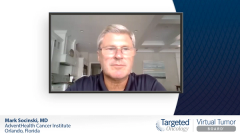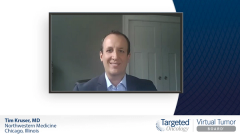
Case 3: PACIFIC Trial in Unresectable Stage III NSCLC
Episodes in this series

Tim Kruser, MD: As we discussed, this patient underwent cisplatin-pemetrexed with concurrent thoracic radiotherapy. He had a partial response with a nice shrinkage, both in the primary and nodal disease. Upon restaging imaging, there was no distant spread observed.
Mark Socinski, MD: This sets up the patient for the PACIFIC data. He’s had a nice response. One question, both for Tim and Ed: Given that there’s some suggestion that earlier immunotherapy is better, how do you handle the restaging of these patients following completion of chemo-RT? I’ll ask Tim first.
Tim Kruser, MD: I do put some credence in those data. The hazard ratio for the patients who got the durvalumab within 14 days was marginally better than most who got it later on. Why you’d like to think that maybe that’s because those were fitter patients, there were also placebo patients who were getting the placebo within 14 days. So the hazard ratio should reflect the activity of the drug in that scenario. It’s something to strive for, and I like to have that discussion with my medical oncologists as they’re getting midway through their radiotherapy: Can we get the scan set up pretty quickly and have this be an expedited transition to the next phase of care?
Mark Socinski, MD: Ed, your thoughts?
Tim Kruser, MD: Yeah, that data subset was really profound, and the design of the study that allowed it was really great because it certainly has always been ingrained in us to let the patient cool off. Let’s give them a couple of months off and let them get recovered. It reminds me of orthopedic surgery, right when you’re done with a knee surgery, you’re putting them in mobility and getting them moving. It’s the same thing here. Don’t stop, hit them while you’re hitting the tumor hard. We like to start within 2 weeks. We like to have a visit 1 week after the completion of chemoradiation, and then starting the durvalumab quickly, shortly afterward. So we’re very aggressive with that.
Mark Socinski, MD: I agree. Occasionally you have a patient who has a great deal of esophagitis or fatigue. They need a little more time to recover. All things being equal, we try to start it. To Tim’s point, I schedule the CT scan within a week after completing radiotherapy, get them authorized, and get them going as quickly as we can. Tim, let’s move on and talk about the PACIFIC trial.
Tim Kruser, MD: Here’s the schema for the PACIFIC trial, which we previewed. Randomized study at 2-to-1 randomization of people who have completed chemoradiotherapy. It’s important to note that these patients, having completed chemoradiotherapy, had a scan that did not show progression. They were then randomized, again 2-to-1, to either durvalumab every 2 weeks or placebo for 1 year. There were coprimary end points of progression-free survival and overall survival, which resulted in sister publications in the New England Journal of Medicine. Here is the overall survival curve. This was updated at ASCO, about 3 years, we’re seeing that 36-month time point. A nice separation of curves early has persisted and numerically actually gotten larger over time, which is encouraging in that it suggests that durvalumab may be curing some patients who would have been otherwise destined to blossom with metastatic disease. It has really catapulted this paradigm into standard of care.
When we look at how these patients progress, the patients on the placebo arm, about a third developed progression disease. That’s cut by about one-third by the use of adjuvant durvalumab. Site by site, those patterns relatively hold in place. A lot of interest on the brain. If you look numerically, it’s about 50% reduction in the brain metastases. Regardless of whether you put a weight on that, it’s probably not statistically valid to say it’s different from the other sites. But I do think that reducing hematogenous disease is going to reduce brain metastases. But we also know that immunotherapy has independent action on brain metastases and might be trying to set up shop. It does work all the extra-thoracic spaces.
Here are some subgroup analyses looking at PD-L1. We can see that there was a nice hazard ratio for those patients with more robust PD-L1 status. All patients were eligible for this study regardless of their PD-L1 status. You notice a fair segment of people did not have PD-L1 testing, unknown category. But some thought-provoking data on whether people with PD-L1–negative tumors may not benefit from this approach. That was not a prespecified or powered analysis. Post hoc analysis—here are the safety summary data. It’s a relatively well-tolerated treatment. If you look at leading to discontinuation, about 15% of patients receiving durvalumab had to discontinue it vs 10% of people receiving placebo. There was nothing particularly surprising here about the safety paradigm for medical oncologists who use these immunotherapy drugs. Commonly, the expected adverse effects in immune-mediated adverse reactions were relatively commonplace. Importantly, the big concern was pneumonitis. How would radiation, thoracic radiation, high-dose radiation play with immunotherapy? While any grade pneumonitis was 33% in the durvalumab arm vs 24% or 25% in the placebo arm, when you look at the high-grade, grade 3/4, they weren’t different, hovering about 3%. This has led people to be quite comfortable with dealing with durvalumab and any pneumonitis that comes thereafter.
Transcript edited for clarity.










































